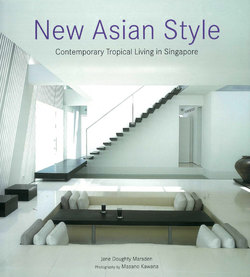Читать книгу New Asian Style - Jane Doughty Marsden - Страница 12
На сайте Литреса книга снята с продажи.
ОглавлениеFar Pavilions
From the moment one ventures past thick granite walls onto a wooden 'drawbridge' suspended over two ponds, poetry and romance are the order of the day. An outstanding example of contemporary tropical vernacular architecture, this two-storey home acts as a series of open-plan pavilions cooled by cross breezes from courtyards and connected by stairs and walkways.
Designed by Ernesto Bedmar, who has pioneered a kind of Balinese style for residences in Singapore, with landscaping by Bali-based Made Wijaya, the house felt so complete to owners Reeta and Sat Pal Khattar that they added only a few specially sourced furnishings. "You cannot have too many things in such an open house and we wanted to continue the feeling of simplicity," says Reeta, an artist born in Penang, Malaysia. "The colours were also important; being so close to nature we chose lots of creams to complement the greenery visible from every room."
The neutrally shaded furnishings mainly from the US are a refined, delicate counterpoint to warm tones of teak, limestone and granite. Asian accents including statues of the family's patron saint, Ganesh, a carved dancer by Balinese master N. Sugara, a cast-iron Shiva's head from southern India and a Peranakan bowl from Malacca lend context to the lofty interior.
Viewed from the master bedroom pavilion, the central courtyard is dotted with palms, coral trees and frangipani. Wijaya also introduced a traditional Balinese compang (raised stone platform) and statuary (unseen).
Now a contemporary design, the drip pattern on this water jar from Thailand (Pacific Nature Landscapes, Singapore) was derived from the days of poor glaze quality. Inspired by a hanging bird's nest, the wrought-iron outdoor lamp was designed by Made Wijaya (Pacific Nature Landscapes).
A white cotton-wool mix sofa set from New York composed around a glass coffee table supported by two temple brackets from southern India complements the airy living room, seen here from the wooden walk-way. On the right, a camphor display cabinet containing Indian, Chinese, Balinese, Indonesian and Japanese antiques makes a rare 'busy' statement. A Kashmiri rug adds colour to the custom-made German wool carpet on the polished limestone floor.
A favourite spot, the verandah features woven water-hyacinth chairs from the Philippines embracing a low table made from a glass-topped Thai pot. Other table bases in the house include a stack of books, a Chinese bamboo basket, a piece of old teak and a bullock cart.
"I wanted a big benevolent Ganesh to bless and welcome everyone who enters the house," says Reeta, who shares Indian heritage with her lawyer husband. At her request, Wijaya shipped an 800 kg (120 stone), 1-m (3-ft) high palimanan statue of the Hindu god of auspicious beginnings from Bali and situated it at the head of the sweeping driveway fashioned from Chinese granite cobblestones.
An atmosphere of gracious living pervades whether the occasion is a breakfast for two on the verandah, complete with monogrammed English tea set, or a traditional wedding ceremony for 400, for which the house was festooned with jasmine and marigolds, with Thai-style krathongs (candlelit floral arrangements) floating in the ponds. "The idea behind the design was to create a tropical-style house with immense peace and security," notes Bedmar of Bedmar& Shi Designers, Singapore.
One end of the living room, from which wooden latticework doors lead to the bedroom pavilion, features a pine and marble table and leather chair from the US.
Water flowing from a terracotta water storage urn from Madura makes an informal shower by the pool.
The ample, grid-patterned, walk-in dressing room in balau wood off the master bedroom conceals clutter and underlines the house's timber theme.
Designed to maximize light and air flow, the downstairs artist's studio-where Reeta spends much of her time-has 10-m (32-ft) high ceilings.
